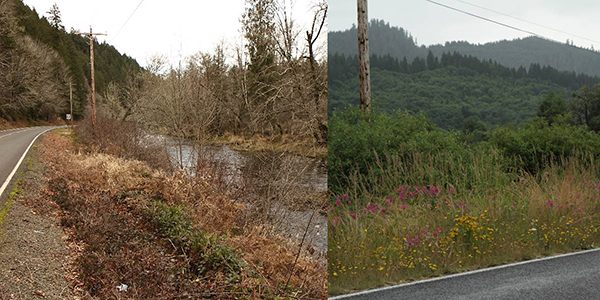Example of broadcast herbicide spray along roads (left). In sharp contrast (right), roads can be pollinator pathways.
Beyond Toxics was one of the members of a Lane County Roadside Integrated Vegetation Management Plan Stakeholders group. The IVMP stakeholder group was very diverse, with members ranging from the Lane County Farm Bureau to NCAP to ODA to Beyond Toxics. The reason I agreed to join the IVMP stakeholder group was to tackle the challenge of researching, writing and working with others to adopt a true Herbicides as a Last Resort Policy. Lane County supposedly had such a policy on the books, but it was never actualized.
My personal and organizational position during the year-long stakeholder process was that roadsides should be managed without the use of herbicides. Happily, I can state that I was not the only stakeholder member to voice this. The environmental advocates, scientists and practitioners on the stakeholders group all agreed that the herbicides are human and environmental poisons that have no place in routine roadside maintenance. Herbicides result in dead zones that are not only ugly and unhealthy, but also create the perfect environment for invasive weeds! The evidence we presented about the harmful impacts of herbicides in the environment helped move the entire group towards recommending very high standards focused on “non-herbicidal control methods,” “prevention,” and protection of public health, environmental health, water, wildlife, aquatic species, amphibians, and pollinators.
We also recommended a lengthy vetting process before any decision can be made to use herbicides. The criteria for establishing a list of allowable herbicides is strictly health protective: no carcinogens, endocrine disruptors, reproductive or neurological toxicants, and nothing that harms pollinators, fish and other species of wildlife. Not only does the Board of Health weigh in to approve a list, but the Director of Public Health and the Lane County Health Advisory Committee also bring their medical and health expertise to the process. The public will also be involved.
The success of this proposed policy is bound to collecting robust environmental data about noxious and invasive weeds. The policy demands that data collection drive the decisions. We must make use of technologies such as new GIS mapping software, weather forecasting, tracking invasive species across a landscape, combined with trained botanists surveying our roadsides to identify weed species and create weed inventories.
Lane County also needs to develop greater tolerance for weeds and “unwanted” vegetation. This tolerance will become more important as we see greater weed variance coming as a result of the effects of warmer weather and dryer landscapes.
Both robust data collection and increased tolerance for unwanted vegetation are part of this proposed policy.
Two scenarios convinced me that I could be part of a consensus vote to approve a limited, very narrow and data-driven IVMP proposal that might include the use of herbicides:
1. A dangerous guardrail on a blind curve is a location where limited herbicide use could be warranted. Workers have been injured while cutting away vegetation underneath guardrails that are constructed between the curved road and a steep embankment. Beyond Toxics supports worker safety and fair treatment of workers.
2. Puncturevine is a noxious weed that can injure livestock, people, and pets when stepped on and can even puncture bicycle tires. It easily spreads via mowing. It is difficult to remove. However, sprayed once, it can be knocked back. Then, because puncturevine doesn't compete well with other vegetation, it can be restrained by encouraging natural vegetation to cover the open areas and reduce the potential for growth.
When I was interviewed for the Register Guard article, I specifically said that I wholeheartedly support the current No Spray Roadside policy. That statement was not reported, but it is important that my position is known. The recommendation for the proposed Vegetation Management Policy is a consensus position from a diverse set of participants in a work group. The recommended policy prioritizes human and environmental health, data-based decision making and strict restrictions on when, how and what herbicides might be used, and only after prevention and non-herbicide methods have been employed. True, the proposed policy is not a complete ban, but it is the “Herbicides as a Last Resort Policy” the County has on the books but was not defined or implemented. This is a health-focused, environmentally-sound model for roadside management. Other city, county or state agencies can adopt this model in order to end the common methods of routine, broadcast and foliar sprays of poisons. Lane County can lead the way to commit to protection, prevention and alternatives to toxics.
Lisa Arkin, Exec.. Director
Beyond Toxics


